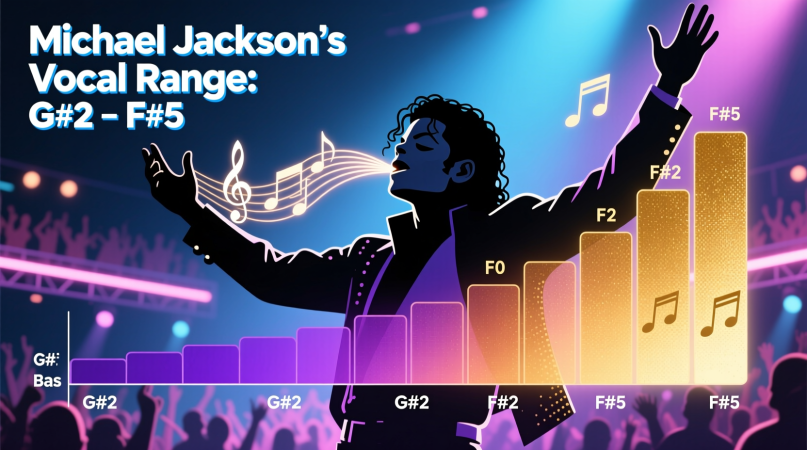
Few artists in music history have sparked as much fascination with their voice as Michael Jackson. While his dancing and stagecraft made him a global icon, his vocal ability remains one of his most studied and debated traits. Fans and analysts often ask: what was Michael Jackson’s vocal range, and how wide was it really?
Let’s break down the verified facts, the disputed claims, and what made his voice unique beyond just numbers.
Understanding Vocal Range
Before diving into Jackson’s specifics, it’s important to understand the basics.
- Definition: A singer’s vocal range is the span from their lowest to highest pitch.
- Everyday people: Around 1.5–2 octaves.
- Trained singers: Often 3–4 octaves.
- Exceptional cases: 4+ octaves, sometimes more.
Range is expressed in scientific pitch notation (like E2 or C6). For example, E2 is a very low note for a male singer, while C6 is impressively high.
If you’re curious how you compare, you can try this vocal range calculator to measure your own span.
Reported Ranges for Michael Jackson
Different sources have published slightly different claims about Jackson’s range:
- SingingCarrots: E2 – C6 (~3.7 octaves)
- RangePlanet forum: F♯2 – C♯6 (~3.5 octaves)
- VocalView: F♯2 – F5 / B5 (depending on classification)
- Diva Devotee: “Bass-baritone with elastic range”
- Seth Riggs (his vocal coach): Claimed 4½ octaves, though this is debated
When cross-referencing, the most consistent evidence suggests E2 to C6, giving him about 3.5 to nearly 4 octaves.
His Lowest Notes
Jackson’s lower register was warm and controlled, though not as heavy as a true baritone’s.
- E2 – Cited in some recordings, often at the very edge of his range.
- F♯2–C3 – Found in live performances and background harmonies.
- C3–E3 – Frequently used in his ballads like Speechless and Stranger in Moscow.
While not his strongest area, his lows added depth to his harmonies.
His Highest Notes
Michael’s higher register is what truly defined his sound.
- Belting range: Up to B4 or C5 in songs like Billie Jean and Beat It.
- Head voice / falsetto: Frequently soared to E5 and above, heard in Don’t Stop ’Til You Get Enough.
- C6: Reported in vocal analyses, though rare and not often sustained.
His mastery of falsetto, combined with his smooth head voice, gave him a light, agile top end.
Usable Range vs. Extremes
It’s important to separate his usable range (what he sang comfortably and often) from his documented extremes:
- Usable range: C3 – E5 (about 2 octaves he used daily).
- Extended range: E2 – C6 (occasional lows and highs).
This helps explain why some fans argue for 3 octaves while others claim 4 or more.
Michael Jackson’s Voice Type
Most vocal coaches classify him as a high tenor (lyric tenor).
- Tessitura (sweet spot): A3 – C5
- Falsetto: Extremely agile, forming a core part of his style
- Lower notes: Present, but less resonant than true baritones
- Flexibility: His tone could shift from delicate and breathy to sharp and powerful
For comparison, you can explore different vocal ranges to see how a tenor like Jackson differs from baritones or sopranos.
Songs That Show His Range
- “Don’t Stop ’Til You Get Enough” – High falsetto notes up to B5.
- “Earth Song” – Emotional belts pushing the upper midrange.
- “Who Is It” – Showcases his rich lower register.
- “Billie Jean” – Uses his chest and head voice mix.
- “Human Nature” – Smooth falsetto transitions.
Frequency Breakdown (Note to Hz Table)
| Note | Frequency (Hz) | Example |
|---|---|---|
| E2 | 82 Hz | Documented extreme low |
| C3 | 130 Hz | Common low note in ballads |
| A4 | 440 Hz | Standard mid belting |
| E5 | 659 Hz | Falsetto / head voice peak |
| C6 | 1046 Hz | Rare extreme high |
Comparisons with Other Artists
| Singer | Range Estimate | Voice Type |
|---|---|---|
| Michael Jackson | E2 – C6 (~3.7 octaves) | Lyric tenor |
| Freddie Mercury | F2 – F6 (~4 octaves) | Tenor |
| Mariah Carey | B2 – G7 (5 octaves+) | Soprano |
| Whitney Houston | C3 – C6 (3 octaves) | Soprano |
| Prince | E2 – B6 (~4 octaves) | High tenor |
This shows Jackson sat among elite vocalists—not always the widest range, but incredibly effective in performance.
Myths About His Range
- “He had 5 octaves.” → No evidence; most credible range: 3.5–4 octaves.
- “He sang lower than a bass.” → Not accurate; his tessitura was closer to tenor.
- “His falsetto was separate from his range.” → False; falsetto counts toward overall span.
FAQs About Michael Jackson’s Vocal Range
What is Michael Jackson’s vocal range?
Most credible estimates place it at E2 to C6 (~3.5–4 octaves).
What is his lowest note?
His lowest recorded note is around E2, though rare.
What is his highest note?
Reports cite C6, though most of his high singing stays below that.
Was Michael Jackson a tenor or baritone?
He is generally classified as a lyric tenor.
Which songs show his range best?
Don’t Stop ’Til You Get Enough, Earth Song, Who Is It, and Human Nature.
Did his range change over time?
Yes. His youthful voice in the Jackson 5 era was lighter and higher; as an adult, his tone deepened but retained agility.
